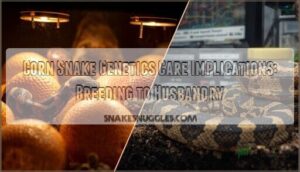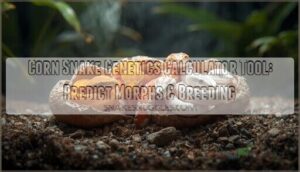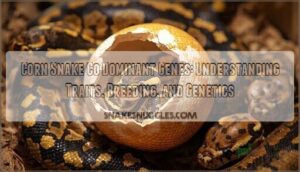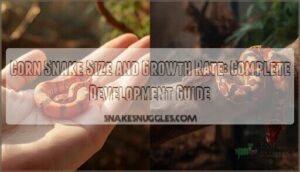This site is supported by our readers. We may earn a commission, at no cost to you, if you purchase through links.
Your corn snake’s mouth contains roughly 20 to 30 tiny, backward-curving teeth arranged in six neat rows—four along the upper jaw and two on the lower. These aren’t the hollow fangs you’d find on a rattlesnake, though. Corn snake teeth are solid, needle-like structures designed for one job: gripping squirming prey long enough to wrap it in deadly coils.
If you’ve ever felt that sudden pinch during handling, you’ve experienced these teeth firsthand. They’re sharp enough to puncture skin but too small to cause serious injury. Understanding how these teeth work, why they’re shaped the way they are, and what to do if you get nipped will help you handle your snake with confidence and keep both of you safe.
Table Of Contents
- Key Takeaways
- Corn Snake Teeth: Key Characteristics
- Dental Anatomy of Corn Snakes
- Do Corn Snakes Have Fangs?
- Are Corn Snakes Venomous?
- Function of Corn Snake Teeth
- Tooth Replacement and Growth
- What Happens During a Corn Snake Bite?
- Treating a Corn Snake Bite
- Preventing Bites From Corn Snakes
- Dental Health in Captive Corn Snakes
- Frequently Asked Questions (FAQs)
- Do corn snakes have teeth?
- Are corn snakes likely to bite?
- Does a pet corn snake bite hurt?
- Are corn snakes aggressive?
- Can corn snake bites transmit bacteria?
- How to prevent corn snake bites?
- Are corn snake bite wounds prone to infection?
- Best practices for feeding corn snakes safely?
- How to calm a stressed corn snake?
- Do corn snake teeth grow back continuously?
- Conclusion
Key Takeaways
- Corn snakes have 20-30 solid, backward-curving teeth arranged in six rows that grip prey like tiny hooks—they’re not venomous fangs and can’t inject toxins, making bites feel like gentle pinches that rarely break skin.
- These teeth replace themselves continuously throughout the snake’s life in three-week cycles, so lost or damaged teeth never become a permanent problem for feeding.
- Bites happen mainly when corn snakes feel stressed, cornered, or mistake your hand for food, but they’re extremely rare in captivity once your snake settles in and trusts you.
- Treating a bite is simple—apply pressure to stop bleeding, rinse with clean water, use antibiotic ointment, and watch for infection signs like spreading redness or fever above 100°F.
Corn Snake Teeth: Key Characteristics
Corn snake teeth might look tiny, but they’re actually quite intricate tools designed for survival. These small, needle-like structures come with a few unique features that help your snake catch and swallow prey with surprising efficiency.
Their hunting prowess extends beyond teeth alone—corn snakes rely on keen nocturnal vision and sensory adaptations to track down prey in dim conditions where other predators struggle.
Let’s break down exactly what makes corn snake teeth so perfectly adapted for the job they do.
Size and Shape of Teeth
Corn snake teeth are surprisingly tiny, with each maxillary tooth measuring just a few millimeters in length. Their aglyphous dentition creates a uniform pattern along the jaw, featuring:
- Sharply pointed, conical crowns that taper to fine tips
- Smooth surfaces without cutting edges or serrations
- Solid construction (no hollow fangs for venom delivery)
- Posterior curvature creating a hooklike profile
This tooth structure evolution makes them perfect grippers, not slicers! Understanding their captive care needs is essential for maintaining healthy corn snakes.
Number of Teeth
Those small teeth add up fast! Adult corn snakes pack well over 100 functional teeth across their jaws—around 50 on each lower jaw side alone, plus numerous upper and palatal teeth. Hatchlings start with fewer dental spots, but tooth count variations increase as they grow. This continuous tooth development throughout life ensures your snake always has a fresh grip on dinner!
Understanding the basics of snake fang anatomy can provide insights into the unique characteristics of venomous and non-venomous snakes.
| Jaw Location | Hatchling Teeth | Adult Teeth |
|---|---|---|
| Lower jaw (each side) | ~30 spots | ~50 spots |
| Upper jaw & palate | Multiple rows | Multiple rows |
| Total complement | 60+ teeth | 100+ teeth |
Tooth replacement keeps these numbers steady despite constant turnover, making dental anatomy fascinatingly active in these non-venomous constrictors.
Curvature and Orientation
Here’s what makes those teeth grip so well—each one curves backward like a tiny hook, angled toward the throat rather than straight down.
This backward orientation creates a one-way system: prey slides in easily but can’t escape forward. That clever tooth angle works with jaw alignment to boost prey retention during feeding mechanics and constriction efficiency, turning your corn snake’s mouth into a perfectly engineered trap!
The backward-curved teeth create a one-way trap—prey slides in easily but can’t escape forward
Dental Anatomy of Corn Snakes
Understanding how a corn snake’s teeth are arranged in its mouth gives you real insight into how these snakes eat and survive. The structure isn’t random—it’s a carefully organized system that helps your snake grip prey and guide it down.
Let’s break down the three key parts of corn snake dental anatomy you need to know.
Understanding these structures matters especially when you’re deciding whether to offer live prey for corn snakes, since defensive rodents can damage delicate mouth tissue.
Tooth Row Arrangement
Your corn snake’s dental patterns reveal a surprisingly complex system—six rows total arranged to optimize prey capture! Unlike the neat rows of human teeth, this reptile dentistry design spreads across multiple jaw bones:
- Two rows on the lower jaw (one per dentary bone)
- Two lateral rows along the outer upper jaw (maxillae)
- Two medial rows on the palatal bones (palatine and pterygoid)
This tooth alignment facilitates continuous feeding mechanics through coordinated jaw movements. Each row undergoes independent tooth replacement throughout the snake’s life, ensuring tooth growth never interrupts your pet’s ability to eat.
Understanding these feeding mechanics helps when selecting a species that matches your experience level, since corn snakes’ efficient tooth structure makes them forgiving eaters for beginners.
The arrangement lets corn snake teeth grip from multiple angles simultaneously, explaining why snake teeth anatomy differs so dramatically from mammals—and why understanding snake teeth and bite mechanics matters for safe handling!
Their powerful bite helps them secure prey like mice and rats, which form the foundation of a healthy corn snake diet in captivity.
Upper and Lower Jaw Structure
Unlike rigid mammalian jaws, your corn snake’s cranial structure features astonishing mandibular flexibility. The two lower jaw bones aren’t fused but connected by stretchy tissue, allowing each side to move independently during feeding.
Meanwhile, maxillary movement occurs through loosely attached upper bones suspended by ligaments. This unique jaw mechanics enables your pet to swallow prey wider than its head.
The tooth alignment across these mobile structures ensures an effective grip from every angle during meals.
Keratin Composition
You might’ve heard that corn snake teeth contain keratin—but here’s the truth: their teeth are actually made of mineralized tissues like dentin and enamel, packed with calcium and phosphorus. Keratin forms their epidermal scales and skin, not their dentition.
This mineral-rich tooth composition gives your snake the hard, durable bite surfaces needed for grasping prey, while keratin provides flexible body protection during movement.
Do Corn Snakes Have Fangs?
No, corn snakes don’t have fangs. This is one of the biggest differences between these harmless constrictors and venomous snakes, and it’s really good news for anyone who keeps them as pets!
Let’s break down what sets regular teeth apart from fangs, and why corn snakes evolved without them.
Difference Between Teeth and Fangs
You need to know this: fangs aren’t just big teeth. Real fangs have grooves or hollow channels that deliver venom from glands straight into prey—like biological syringes.
Corn snake teeth are solid, sharp little hooks without any venom delivery system. They grip and hold, nothing more.
Venomous snakes use specialized fang anatomy for chemical warfare; your corn snake relies purely on mechanical tooth structure and constriction instead.
Why Corn Snakes Lack Fangs
Evolutionary tradeoffs shaped corn snake teeth over millions of years. When constriction mechanics work perfectly for catching prey, venomous fangs become unnecessary baggage—so your corn snake kept its ancestral traits instead.
Tooth morphology stayed simple and effective: multiple recurved teeth for gripping beat a few costly fangs any day. Venomless predation through pure muscle power proved more than enough, eliminating selection pressure for venom delivery entirely!
Are Corn Snakes Venomous?
No, corn snakes aren’t venomous at all! They don’t have the specialized venom glands or fangs needed to inject toxins into prey or predators.
Let’s break down how venom actually works in snakes and why you can rest easy knowing corn snake bites are harmless.
Venom Delivery in Snakes
Venomous snakes rely on specialized toxin delivery systems that corn snakes simply don’t have. Front-fanged vipers and elapids possess tubular fangs connected to venom glands with muscular compressors that squeeze toxins at high pressure, like a biological syringe. Even rear-fanged species have enlarged grooved teeth and Duvernoy’s glands for venom flow. Corn snake teeth? They’re just curved grippers without any venom apparatus whatsoever.
Corn Snake Bite Safety
Corn snake bites are about as harmless as they get. You’ll feel a quick pinch and see tiny arc-shaped marks, not deep wounds requiring emergency response. Most bites don’t even bleed! Since there’s no venom involved, basic wound care—soap, water, antiseptic—manages everything.
Proper snake handling and bite prevention through calm movements mean you’ll rarely face this situation anyway. These snakes would rather flee than fight.
Function of Corn Snake Teeth
Corn snake teeth aren’t just decorative—they’re incredibly specialized tools that make hunting and eating possible. Every single tooth plays a specific role in how these snakes capture, secure, and consume their prey.
Let’s look at the three main functions that make corn snake teeth so effective.
Grasping and Holding Prey
When your corn snake strikes, those backward-curved teeth work like tiny hooks, anchoring prey the instant it makes contact. The tooth curvature isn’t just for show—it creates a ratchet effect that prevents escape during the critical first moments of capture.
As a constrictor, your snake depends on this secure grip to position prey correctly before wrapping its coils, combining jaw mechanics with its constricting mechanism for effective feeding behavior.
Assisting in Swallowing
Once your snake has subdued its meal, those same backward teeth play a different role—walking the prey down the throat. Tooth alignment on the upper and lower jaws creates alternating grip points that let your corn snake “climb” over its food through rhythmic jaw movement.
This swallowing process relies on reptile dentition working with flexible skull bones, inching prey toward the digestive system without any chewing involved.
Role in Constriction
Those backward teeth don’t kill prey—your snake’s body coils do the work. But here’s where tooth function really matters: recurved corn snake teeth lock onto the prey’s head or body during that split-second strike, giving your constrictor the grip stability it needs to throw coils around struggling prey.
Without that dental anchor point, constriction mechanics would fail before the first loop tightened, letting dinner escape every time.
Tooth Replacement and Growth
Corn snakes don’t worry about losing a tooth here and there—it’s part of their natural design! Their teeth are replaced regularly throughout their entire life, kind of like how sharks continuously grow new teeth.
Let’s look at how this renewal process works and what it means for your snake’s dental health.
How Teeth Are Replaced
Unlike mammals that lose teeth once, your corn snake has a built-in renewal system that works like magic! Here’s how dental regeneration operates in these fascinating reptiles:
- New tooth germs form continuously along a specialized tissue called the dental lamina
- Replacement teeth develop behind each functional tooth in organized rows
- Odontoclasts invade from within, weakening the old tooth through internal tooth resorption
- The weakened tooth detaches during the replacement cycle
- Fresh teeth slide into position, maintaining your snake’s bite
This tooth shedding process ensures your corn snake never runs out of teeth!
Frequency of Tooth Loss
Your corn snake loses teeth more often than you’d think! Tooth shedding rates can reach impressive levels during feeding, with multiple teeth lost in a single meal.
The replacement cycles run about three weeks from start to finish, meaning dental renewal happens continuously. Internal tooth resorption weakens old teeth so they detach cleanly, and tooth loss patterns help maintain your snake’s dental health throughout its life.
Lifelong Dental Renewal
Tooth regeneration keeps working from hatchling to senior years, giving your corn snake lifelong resilience that most animals can’t match. Snake dentition stays functional through continuous dental renewal, ensuring your pet never runs out of working teeth!
Here’s what lifelong tooth replacement means for snake behavior and reptile care:
- Active stem cells in the dental lamina keep producing new teeth throughout your corn snake’s entire lifespan
- Multiple tooth generations develop simultaneously along the jaw, maintaining constant readiness for replacement
- Rapid three-week cycles guarantee snake anatomy adapts quickly to any tooth loss during feeding
- Internal resorption mode allows smooth substitution without leaving empty gaps in the mouth
- Preserved dental health means adult snakes maintain the same grasping capacity they’d as juveniles
This built-in renewal system is what makes corn snakes such resilient feeders—tooth damage never becomes a permanent problem!
What Happens During a Corn Snake Bite?
If your corn snake does bite you, don’t panic—it’s usually over in a flash and far less dramatic than you might expect. The experience is generally brief, mild, and rarely causes more than a small scratch or pinch.
Let’s walk through what actually happens during a bite so you know exactly what to expect.
Typical Bite Behavior
When your corn snake feels cornered or stressed, it’ll strike fast—not because it’s aggressive, but as a warning. You might notice a coiled body, gaping mouth, or quick head movements before the bite happens.
Handling frequency, temperature swings, and disturbances after feeding all increase bite risk. Most defensive strikes are brief, though repeated handling without breaks can trigger more forceful attempts to escape.
Pain and Injury Level
Most corn snake bites feel like a gentle pinch or toothbrush bristles—owners often say they’re less painful than kitten scratches! Here’s what you can expect:
- Bite severity: Tiny pin pricks that rarely break skin deeply
- Pain threshold: Brief discomfort, far milder than paper cuts
- Injury response: Minimal bleeding that stops quickly with rinsing
These nonvenomous snake bites pose almost no trauma risk compared to venomous snakes.
Bite Frequency in Captivity
Here’s the good news: captive corn snakes rarely bite! Bite patterns emerge mostly during the first month after adoption as your snake acclimates—it needs time to settle in.
Feeding schedules also play a role, as mealtimes can trigger defensive instincts. Captive stress, often from frequent handling or enclosure changes, increases the likelihood of incidents.
However, once your snake feels secure, bites become extremely uncommon with proper corn snake care and ownership practices.
Treating a Corn Snake Bite
If a corn snake does bite you, don’t panic—it’s not a medical emergency. The good news is that treating the bite is simple and straightforward, with just a few basic steps you’ll want to follow.
Here’s exactly what you need to do to care for the wound and when you might need extra help.
First Aid Steps
If you get nipped by your corn snake, don’t panic—this bite response is manageable! Here’s your quick emergency procedures checklist:
- Apply direct pressure with clean gauze for at least 5 minutes to stop any bleeding
- Rinse the wound with cool, clean water to remove debris
- Skip the soap directly on the puncture—it’ll sting unnecessarily
- Monitor for unusual swelling, redness, or fever over the next day or two
Stay calm, and you’ll be just fine!
Cleaning and Disinfecting The Wound
Once bleeding stops, it’s time for proper wound cleaning and infection control. Rinse the bite site under clean running water for at least 5 minutes, then gently pat dry with sterile gauze.
Apply a thin layer of antibiotic ointment to support wound healing, then cover with a clean bandage. This simple bite aftercare routine prevents most complications from animal bites!
When to Seek Medical Attention
Most corn snake bites heal without fuss, but watch for infection signs like increasing redness spreading beyond the wound, pus, red streaks, or fever above 100°F. These signal you need professional wound assessment and snake bites treatment.
If bleeding won’t stop after 15 minutes of pressure, or if you haven’t had a tetanus shot in five years, call your doctor—tetanus risks from bite wound care aren’t worth gambling on!
Preventing Bites From Corn Snakes
The good news is that corn snake bites are easy to avoid once you understand what triggers them.
A few smart habits around handling, feeding, and daily care can keep your snake calm and your fingers safe.
Let’s walk through the simple practices that prevent most bites before they happen.
Handling Techniques
Slow, steady movements are your best friends when handling corn snakes. Support their entire body with a gentle approach and secure grip—never grab or jerk suddenly. Keep your posture relaxed to show you’re no threat.
These simple reptile handling techniques and calming methods make all the difference, turning safe lifting into second nature and helping you master stress reduction through proper handling practices.
Reducing Snake Stress
Calm environments and stress-free handling go hand-in-hand with gentle interaction. Your corn snake needs predictability and security to feel safe. Here’s how to create reduced anxiety through proper snake enrichment:
- Maintain consistent temperatures with a thermal gradient so your snake can self-regulate and stay comfortable
- Provide secure hides on both warm and cool ends for retreat during disturbances
- Follow a routine schedule for cleaning and feeding to minimize unpredictability and support reptile handling and safety
Understanding snake behavior and body language helps you master pet snake ownership. A calm environment truly prevents defensive bites!
Safe Feeding Practices
Smart feeding minimizes stress and bites. Prey Size Guidelines state your Corn Snake needs appropriately sized meals—no wider than the thickest part of their body. Feeding Frequency for adult pet snakes is every 7–14 days, supporting Nutrition Balance and Digestion Monitoring.
Use pre-killed prey to reduce injury risk during Snake Feeding. Proper Handling Techniques mean avoiding contact 24–48 hours post-meal. These Reptile Care practices keep Snake Care stress-free!
Dental Health in Captive Corn Snakes
Your corn snake’s teeth are usually low-maintenance, but problems can pop up if something goes wrong during feeding or if bacteria gets into the mouth.
Catching dental issues early makes a big difference in keeping your snake healthy and comfortable. Here’s what to watch for and when it’s time to call the vet.
Common Dental Issues
Your corn snake’s dental health can take a hit from several issues, and knowing them keeps your pet snake safe! Infectious stomatitis, or mouth rot, is the big one—bacteria infect the gums and tissues.
Oral trauma from striking cage walls or live prey can break teeth and tear tissue. You might also see gum disease from poor hygiene or retained broken teeth causing chronic problems.
Signs of Dental Problems
Vigilance is your best friend when protecting your pet reptiles and animals from dental health disasters! Watch closely for these red flags that signal gum disease, oral infection, or dental trauma in your constrictor:
- Persistent bleeding during handling or after a snake bite
- Swollen, red gums around the tooth lines
- Discolored or loose teeth indicating decay or jaw malformation
- Difficulty eating or excessive drooling
Veterinary Care for Teeth
Your exotic veterinarian will perform careful oral exams to spot broken teeth, gum infections, or jaw misalignment early! Here’s what professional snake dentistry involves:
| Diagnostic Tool | Purpose | When Used |
|---|---|---|
| Dental Xrays | Evaluate tooth roots and bone loss | Suspected fractures or abscesses |
| Oral Swabs | Identify bacterial or fungal infections | Visible inflammation or discharge |
| Visual Exam | Check tooth integrity and gum health | Routine wellness visits |
| Palpation | Detect loose or damaged teeth | When bite behavior changes |
Tooth extraction and oral surgery may be necessary for severely diseased teeth, followed by antibiotics and pain management to support reptile health and wellness!
Frequently Asked Questions (FAQs)
Do corn snakes have teeth?
Yes, your pet absolutely has teeth—multiple rows of them! Corn snakes possess about 20-30 small, needle-like teeth arranged in six rows across their upper and lower jaws for gripping prey.
Are corn snakes likely to bite?
These pet snakes are docile and rarely bite in captivity. Bites usually happen only when they’re stressed, scared, or mistake your hand for food during feeding time.
Does a pet corn snake bite hurt?
Honestly? A pet corn snake bite feels like a gentle pinch or paper cut—barely noticeable! Most bites cause minimal pain, minor scratches, and quick wound healing, making injury prevention easy with calm snake behavior and proper handling.
Are corn snakes aggressive?
Corn snakes are docile, not aggressive. You’ll rarely see defensive postures or handling problems with proper stress management.
These non-venomous snakes don’t bite unless they’re frightened, making them perfect for beginners learning snake behavior.
Can corn snake bites transmit bacteria?
While these snakes aren’t venomous, their mouths do harbor bacteria like Staphylococcus that can enter wounds.
Wash any bite thoroughly with soap and water immediately, then apply antiseptic to prevent infection.
How to prevent corn snake bites?
You can prevent corn snake bites through calm handling techniques, recognizing stress signals, and using feeding tools.
Support the entire body, avoid sudden movements, and wash hands to remove prey scents!
Are corn snake bite wounds prone to infection?
You’d think these gentle constrictors were plotting biological warfare!
In reality, corn snake bites rarely get infected—studies show infection rates under 1%—provided you clean the wound promptly with soap and water.
Best practices for feeding corn snakes safely?
You’ll want feeding tools like long tongs to keep hands safe during meals. Offer pre-killed prey that’s appropriately sized, avoiding loose substrates in your pet snake’s enclosure. Wait 24-48 hours post-feeding before handling constrictors.
How to calm a stressed corn snake?
You can calm a stressed corn snake by providing secure hides, maintaining stable temperatures, minimizing sudden movements, and limiting handling sessions to 5–15 minutes until your pet snake shows relaxed behavior.
Do corn snake teeth grow back continuously?
Your corn snake’s teeth grow back through lifelong tooth replacement cycles, not uninterrupted growth. This polyphyodonty means new teeth continuously replace lost ones throughout the snake’s life, ensuring functional dentition for feeding and bite safety.
Conclusion
Knowledge is power, especially regarding understanding your snake. Now that you know how corn snake teeth work—those backward hooks gripping prey, those solid rows lacking venom—you can handle your pet with confidence instead of fear.
A nip might surprise you, but it won’t harm you. Respect their nature, watch for feeding cues, and keep handling gentle. Your corn snake isn’t dangerous; it’s just being a snake.
- https://anatomypubs.onlinelibrary.wiley.com/doi/10.1002/dvdy.120
- https://pmc.ncbi.nlm.nih.gov/articles/PMC7346461/
- https://www.reddit.com/r/snakes/comments/14a1e47/rearfang_venomous/
- http://ecoevocommunity.nature.com/posts/the-secrets-inside-snake-teeth
- https://www.sciencedirect.com/science/article/pii/S0012160608001942


















